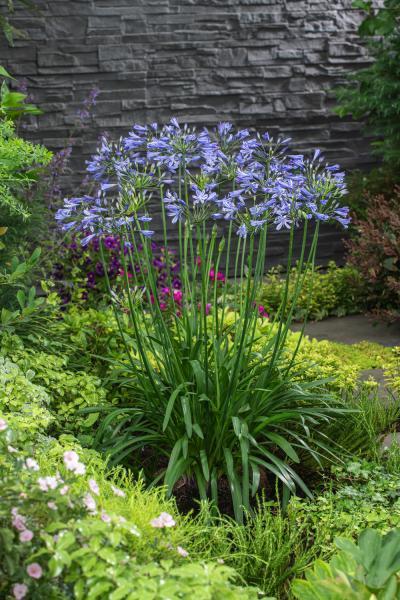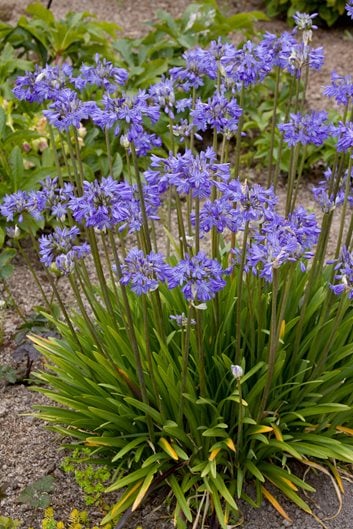Growing Agapanthus: A Total Guide to Beautiful Blooms
Wiki Article
Mastering the Art of Agapanthus Treatment: Necessary Steps for Healthy Development and Vivid Blossoms
In the realm of gardening, the cultivation of agapanthus stands as a gratifying undertaking for those who seek to support these classy blooming plants. With their striking blossoms and elegant vegetation, agapanthus has captured the attention of gardeners worldwide. Nevertheless, accomplishing optimum development and lively blooms requires a nuanced technique that incorporates numerous important steps. From picking the ideal selection to understanding pruning techniques, the trip in the direction of cultivating flourishing agapanthus plants is complex and holds the essential to opening the full possibility of these organic treasures.
Choosing the Right Agapanthus Range

When choosing the best Agapanthus variety for your yard, take into consideration variables such as climate viability, flower shade, and development practice. Agapanthus, commonly referred to as Lily of the Nile or African lily, can be found in a selection of shades ranging from tones of purple and blue to white. Select a blossom shade that enhances your existing garden palette to produce a harmonious landscape. Furthermore, consider the climate in your area to make certain the Agapanthus selection you choose can prosper in your certain problems. Some ranges are much more forgiving of cool temperature levels, while others favor warmer environments. Comprehending the growth routine of different Agapanthus ranges is important for appropriate placement within your yard. Some selections have a clumping growth behavior, suitable for containers or borders, while others have an even more dispersing nature, appropriate for ground cover or mass plantings. By thoroughly examining these elements, you can choose the excellent Agapanthus selection to enhance the charm of your yard.
Suitable Planting Conditions
Taking into consideration the ideal ecological requirements is essential for effective Agapanthus growing. Agapanthus plants are delicate to chilly temperature levels and ought to be secured from frost during winter season months.To guarantee healthy growth and lively blooms, plant Agapanthus bulbs at a deepness of about 2-4 inches and area them 8-12 inches apart. Mulching around the base of the plants aids maintain wetness and subdues weed growth.
Watering and Fertilizing Tips
Maintaining proper dampness degrees and providing vital nutrients are key aspects in the care routine for Agapanthus plants. When it pertains to sprinkling Agapanthus, it is important to strike an equilibrium. These plants like regularly damp soil but are at risk to root rot if overwatered. During the expanding season, water deeply as soon as a week, making sure the soil is well-draining to avoid waterlogging. In hotter climates or throughout periods of drought, even This Site more constant watering might be essential to keep the dirt evenly moist. However, lower watering in the winter months to protect against waterlogged conditions.Fertilizing Agapanthus is necessary for promoting healthy development and respected flowers. Apply a balanced fertilizer, such as a 10-10-10 formula, in the early spring as new development emerges. By following these watering and feeding pointers, you can guarantee your Agapanthus plants flourish and create lively, durable blossoms.
Trimming Strategies for Agapanthus
Pruning Agapanthus plants at the suitable times and with proper strategies is critical for maintaining their wellness and promoting optimal growth and blooming. The optimal time to prune Agapanthus is in late winter months or very early springtime prior to new growth emerges.Deadheading invested blossoms can additionally reroute the plant's power right into generating even more flowers rather than setting seeds. If you want to gather seeds for proliferation, leave some blossoms to dry and fully grown on the plant.
Keep in mind to make use of tidy, sharp devices to make specific cuts and reduce the danger of presenting illness. Agapanthus. Regular pruning will aid maintain your Agapanthus looking healthy and balanced and cool while making certain an abundant display of beautiful blooms
Taking Care Of Common Insects and Illness
After ensuring correct trimming methods for Agapanthus, it is crucial to address usual bugs and conditions that can impact the health and vigor of these plants. One usual bug that affects Agapanthus Visit Website is the Agapanthus gall midge.Another usual concern is fungal leaf spot, which offers as dark sores on the leaves. To stop fungal illness, ensure excellent air flow around the plants, prevent above watering, and remove any type of infected fallen leaves without delay. Furthermore, Agapanthus plants can deal with origin rot if they are planted in improperly draining pipes soil. To stop this, plant Agapanthus in well-draining soil and prevent overwatering. By being attentive and taking punctual action versus conditions and pests, you can aid your Agapanthus plants grow and produce vibrant blooms.

Verdict
Finally, understanding the art of agapanthus treatment entails selecting the appropriate range, providing optimal planting conditions, appropriate watering and feeding, ideal trimming techniques, and dealing with usual bugs and illness. By complying with these essential steps, you can guarantee healthy growth and vivid blooms for your agapanthus plants. Remember to routinely monitor and keep your plants to promote their general well-being and durability.To ensure healthy growth and lively blossoms, plant Agapanthus light bulbs at a deepness of concerning 2-4 inches and room them 8-12 inches apart. By following these watering and fertilizing ideas, you can guarantee your Agapanthus plants flourish and generate vibrant, durable blooms.
One common bug that influences Agapanthus is the Agapanthus gall midge. In addition, Agapanthus plants Visit Your URL can endure from root rot if they are planted in badly draining pipes soil. By following these important actions, you can guarantee healthy growth and lively flowers for your agapanthus plants.
Report this wiki page